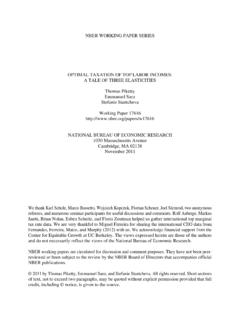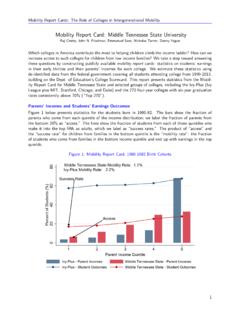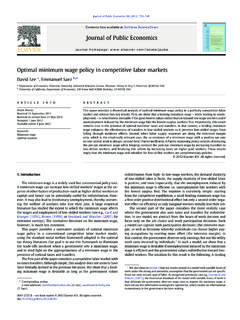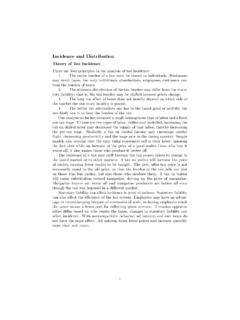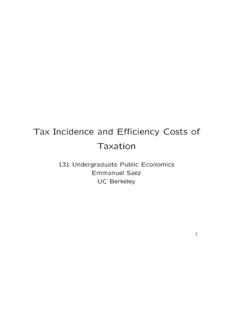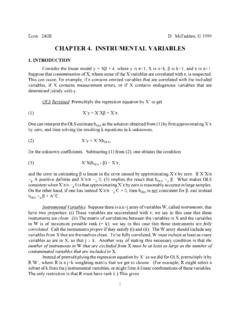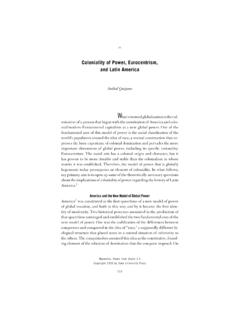Transcription of Universal Basic Income in the US and Advanced Countries
1 NBER WORKING PAPER SERIES. Universal Basic Income IN THE US AND Advanced Countries . Hilary W. Hoynes Jesse Rothstein Working Paper 25538. NATIONAL BUREAU OF ECONOMIC RESEARCH. 1050 Massachusetts Avenue Cambridge, MA 02138. February 2019. This paper was invited for a Symposium on Universal Basic Income in Annual Review of Economics. We thank James Hawkins, Krista Ruffini, and Rachel Young for excellent research assistance, and Marianne Bitler, Lauren Burns-Coady, Angus Deaton, Bill Gale, Irv Garfinkel, Robert Moffitt, Austin Nichols, Paul Niehaus, and Diane Schanzenbach for helpful comments and discussions. The views expressed herein are those of the authors and do not necessarily reflect the views of the National Bureau of Economic Research. NBER working papers are circulated for discussion and comment purposes. They have not been peer-reviewed or been subject to the review by the NBER Board of Directors that accompanies official NBER publications.
2 2019 by Hilary W. Hoynes and Jesse Rothstein. All rights reserved. Short sections of text, not to exceed two paragraphs, may be quoted without explicit permission provided that full credit, including notice, is given to the source. Universal Basic Income in the US and Advanced Countries Hilary W. Hoynes and Jesse Rothstein NBER Working Paper No. 25538. February 2019. JEL No. H24,I3,I38. ABSTRACT. We discuss the potential role of Universal Basic Incomes (UBIs) in Advanced Countries . A feature of Advanced economies that distinguishes them from developing Countries is the existence of well developed, if often incomplete, safety nets. We develop a framework for describing transfer programs, flexible enough to encompass most existing programs as well as UBIs, and use this framework to compare various UBIs to the existing constellation of programs in the United States.
3 A UBI would direct much larger shares of transfers to childless, non-elderly, non-disabled households than existing programs, and much more to middle- Income rather than poor households. A UBI large enough to increase transfers to low- Income families would be enormously expensive. We review the labor supply literature for evidence on the likely impacts of a UBI. We argue that the ongoing UBI pilot studies will do little to resolve the major outstanding questions. Hilary W. Hoynes Richard & Rhoda Goldman School of Public Policy University of California, Berkeley 2607 Hearst Avenue Berkeley, CA 94720-7320. and NBER. Jesse Rothstein Goldman School of Public Policy and Department of Economics University of California, Berkeley 2607 Hearst Avenue #7320. Berkeley, CA 94720-7320. and NBER. I. Introduction Universal Basic Income (UBI) proposals are getting a lot of attention in the high- Income Countries .
4 A wide range of proponents, from Charles Murray, a political scientist and scholar at the American Enterprise Institute, to Andy Stern, former president of the Service Employees International Union, have backed the idea. We count six recent, high-profile trade books . including those by Murray and Stern arguing for various forms of UBI as solutions to problems facing first-world economies (Murray 2016; Stern 2016, Lowrey 2018, Yang 2018, Hughes 2018, Van Parijs and Vanderborght 2017). Using a metric of mentions in New York Times articles, Universal Basic Income appears 30 times in 2017, and nearly as many in the first six months of 2018. The term never appeared before 2014; even the more expansive search term of Basic Income averaged only two uses per year from 1945 to 2014 (Figure 1).1. Attention may be running ahead of actual policy development: there is little agreement or definition what exactly a UBI is.
5 And Basic questions remain unresolved: about what specific problems the program is meant to solve; about how the program relates and compares to other existing transfer programs; and about the key research questions that need to be answered. Our paper attempts to fill this gap. We comprehensively examine the potential role of UBIs in Advanced We take three features to define a UBI: a) it provides a sufficiently generous cash benefit to live on, without other earnings;. b) it does not phase out or phases out only slowly as earnings rise; and c) it is available to a large proportion of the population, rather than being targeted to a particular subset ( , to single mothers). As we discuss below, many proposals and programs that use the name UBI depart from this canonical structure in important ways. Indeed, some authors would disagree with our definition for example, Van Parijs and Vanderborght (2017) and Banerjee, Niehaus, and Suri (2018).
6 Would include small transfers that meet criteria (b) and (c) but not (a) as UBIs. We begin, in Section II, by discussing a range of problems for which a UBI might be seen as a solution. One commonly cited reason to adopt a UBI is the combination of labor-displacing technological change journalist Annie Lowrey calls this the robot apocalypse (Lowrey 2018). and rising inequality and wage stagnation. Alternatively, a UBI might be seen as a response to perceived inadequacies -- ineffectiveness, inefficiencies, unfairness, contingency, or insufficiency -- of the current social safety net. These are quite different motivations, with 1. The recent interest recalls discussions in the 1960s and 1970s about proposals for demogrants, negative Income taxes, social dividends, and other UBI-like programs (see, , Friedman 1962; Moffitt 2003a; Garfinkel, Huang.)
7 , &. Naidich 2005; and Sloman 2016). These discussions are reviewed in part by Nichols and Rothstein (2016) and Ventry (2000). We discuss negative Income taxes extensively below. 2. There is also an active discussion about UBIs in poor Countries , where the issues and existing infrastructure are quite different. See Banerjee et al. (2018) and Hanna and Olken (2018) for discussions of UBIs in that context. 1. important implications for the prospects of a program that could represent a substantial increase in the generosity (and cost) of transfer payments relative to existing programs. In Section III we develop a framework for comparing a wide range of transfer programs, and use this to place the UBI within the context of the canonical Income support programs routinely provided by Advanced Countries . Our framework is simple but general, using six parameters to nest a wide range of transfer programs including cash welfare, in-work tax based assistance, child allowances, social security retirement, negative Income taxes, and UBIs.
8 We use this framework to discuss several possible interpretations of the words Universal and Basic Income . We also discuss the various UBIs in proposal or pilot form and how they compare to a canonical UBI. In Section IV, we discuss the distributional implications of a UBI. Focusing on the , we explore the distribution of transfers received under current law. A large share of current transfer spending goes to specific populations, particularly families with children, the elderly, and the disabled, and eligibility is often heavily means tested. A UBI would substantially smooth out the currently uneven distribution, with dramatic distributional effects. If a UBI of the scale often contemplated were introduced on top of the existing transfer system, it would represent a very large downward redistribution of Income . In contrast, a UBI that replaced, rather than supplemented, current programs would be less targeted, providing much less assistance to the lowest Income families.
9 Compared to the existing combination of transfer programs, a canonical UBI would also direct a much larger share of funds to younger, non-disabled workers and to families without children (and smaller shares going to the elderly, disabled, and families with children). In section IV, and throughout the paper, we embed our discussion in the program ecosystem. While it is necessary to adopt a particular setting to provide the needed quantitative analysis, the main conclusions of the paper are qualitative and will apply in all Advanced Countries . It is worth pointing out, however, that the provides much less generous Income transfers, with much more of a focus on work, than do most other developed Countries . A UBI would thus be a larger change, both philosophically and in terms of the distribution of funds, in the than elsewhere.
10 Section IV also discusses the cost of a UBI, again in the context. A truly Universal UBI would be enormously expensive. The kinds of UBIs often discussed would cost nearly double current total spending on the big three programs (Social Security, Medicare, and Medicaid). Moreover, each of these programs would likely be necessary even if a UBI were in place, as each addresses needs that would not be well served by a uniform cash transfer. Expenditures on other existing programs sum up to only a small fraction of the cost of a meaningful UBI. This suggests that a full-scale UBI would require substantial increases in government revenue. The impacts of whatever taxes are imposed to generate this revenue are likely of first-order importance in evaluating the impact of a This consideration suggests that a UBI is less 3. This point is also made by Hanna and Olken (2018).

